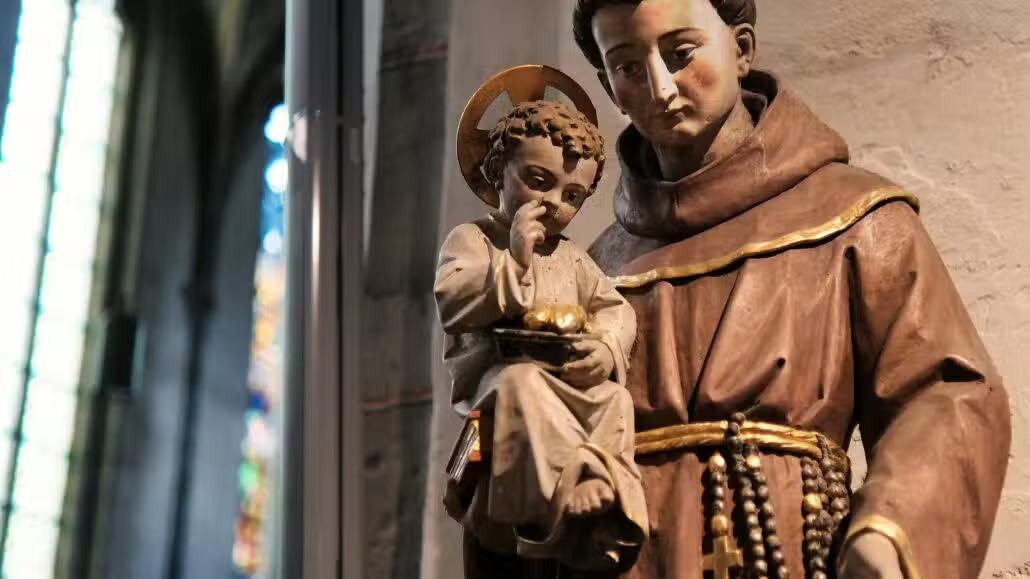It was not until the year 2002 that I discovered the very first book ever written about Saint Anthony of Padua. It’s an extraordinary little book that was published in Latin in 1232, but apparently had no English translation until 1984. The title used for this first life of Saint Anthony was simply the First Life (Vita Prima in Latin) or the Assidua (because assidua happened to be the first Latin word of the little book). The book was published one year after Anthony’s death, which occurred on June 13, 1231.
A Franciscan friar, who chose to remain anonymous, wrote this short biography at the request of his community for the occasion of Saint Anthony’s canonization (in 1232). Since it was written so soon after his death and by a confrere who obviously knew the saint, the book is considered a reliable source for the basic facts of Anthony’s life.
One thing that jumped out at me in my first reading of this book was that Anthony was truly a contemplative. I don’t mean this in the sense that he totally left the world and became a lifelong hermit or a cloistered monk who never stepped outside the walls of his monastery. Rather, he was a contemplative in the sense that he possessed a desire or longing to search for the face of God and to live totally for God—and he pursued that inner longing with noticeable frequency throughout his life. As we shall see, the longing never really left him.
This contemplative yearning was also clearly evident in the life of Saint Francis of Assisi, whose example Anthony was certainly following. Both Francis and Anthony had this contemplative thirst, this need to seek God often in solitude so as to live for God alone.
In the pages of the First Life, as well as in other sources, we certainly see this need in Anthony. Time and again, Anthony simply experienced the need to step aside from his regular activities and search for God in solitary places like caves or little hermitages. And he did this for rather long stretches of time. This article is something of a retracing of Anthony’s life journey, but with a heavy emphasis on the saint’s contemplative search.
Anthony’s Contemplative Search Begins Early
Anyone who looks carefully through the pages of the First Life will notice both strong as well as subtle signs of his contemplative temperament. We learn very quickly that his parents lived in Lisbon, very close to the cathedral church. They “gave him the name Ferdinand at the holy font of baptism,” says the First Life.
“Indeed, they entrusted him to this church,” the book adds in its early pages, “so that he learn the sacred writings there.” Here already we have a strong clue of early opportunities provided Anthony by his faith-filled parents to search devoutly for God in the pages of the Bible under the guidance of the cathedral clergy.
Then, at age 15, according to the First Life, Ferdinand withdrew from the world and entered the Augustinian monastery nearby—another clear sign of his early longing to seek the face of God before all else. After living in this monastery for two years, he sought to find an even better climate for his contemplative search. Ferdinand still found that his search for God in Lisbon was compromised because his old friends kept trying to visit him at the monastery.
As a result, and as if to reinforce his desire for a “more fruitful tranquility,” Ferdinand asked his superiors to transfer him to the Augustinian monastery in the city of Coimbra, the capital of Portugal at the time, 100 miles north of Lisbon.
In Coimbra, he cultivated his inner life with frequent meditation and the reading of Scripture, “examining…the deep sense of God’s words,” as well as “the words of the saints with diligent inquiry. And, indeed,” the First Life adds, “he entrusted to his tenacious memory whatever he read so that in short time he was able to acquire a knowledge of the Scriptures that no one else hoped to possess.”
Saint’s Journey Takes Surprising Turn
Ferdinand’s journey toward God, however, soon jumped to a new level of intensity. It happened that the relics of five holy Franciscan martyrs, beheaded in Morocco for preaching Christianity to the Muslims, were brought to Coimbra amidst great publicity and fervor. On learning about the great faith and heroism of these Franciscan martyrs, Ferdinand felt strongly inspired to follow in their footsteps.
Not far from the monastery where Ferdinand was staying, there lived a group of Franciscan friars. These friars often came begging at the door of the Augustinian monastery. Ferdinand spoke earnestly to the Franciscans about his desire to become a Franciscan, especially if they would promise to send him to Morocco to become a martyr for Christ. With great joy, the friars said that, in two days, they could invest him in the Franciscan habit.
And so it happened that Ferdinand, the Augustinian, became Anthony, the Franciscan. He took the name in honor of Saint Anthony of Egypt, the patron of the church where he was living with the other Franciscans. Choosing this name is yet another clue that the contemplative life had a special appeal for him.
Saint Anthony of Egypt was a famous fourth-century hermit, considered to be one of the early founders of monasticism. Anthony of Egypt had spent long years in the desert and other isolated places, giving himself over to contemplative prayer.
But contemplation did not seem to be the young Franciscan friar’s main priority at that moment. He was eager to embark for Morocco to evangelize the Muslims, even at the risk of losing his own life out of love for Christ.
Anthony’s Dream Is Frustrated
Anthony, however, became deathly sick in Morocco and had to sail back to Portugal to regain his health. On the journey home, a strong wind swept the ship badly off course and it landed in Sicily.
We can only imagine that his failure to carry out his mission of preaching to the Muslims had to be a devastating blow for him. He must have felt a great sense of humiliation in falling so short of his grand dreams, even if it was because of serious illness. And exactly what kind of illness was it? Was it a physical illness such as malaria? Or could it have been the result of what some modern eyes might see as a kind of psychological phenomenon like culture shock or a sudden loss of confidence? We may never know for sure.
Up to this time, however, Anthony seemed to be on the fast track toward spiritual perfection. He was a bright light as an Augustinian friar and student of the Scriptures and of other theological courses. He showed great initiative in asking to be sent to Coimbra, where the discipline was harder and where his talents and religious zeal could shine. Then he opted for a greater challenge still: Joining this new Franciscan brotherhood—spreading like wildfire across Europe—and personally setting off with great confidence to imitate those heroic martyrs whose bones had been carried triumphantly into Coimbra.
Maybe this humbling experience of failing as a preacher to the Muslims led Anthony to the insight that he had to rely less on his own human wisdom and talents and more on the saving power of God. Maybe he had to learn the spiritual wisdom hidden in the psalmist’s words: “Unless the Lord build the house, they labor in vain who build it” (Psalm 127:1).
Anthony Recovers His Health
In any case, we can assume that Anthony was still sick or down in the dumps when he reached the coast of Sicily. The friars there did what they could to nurse him back to wholeness. They encouraged him to go along with them to the Pentecost Chapter of 1221 near Assisi, a large meeting of Franciscan friars, several thousand strong, who were coming from all regions where the Franciscans were serving. The Order’s founder, Saint Francis of Assisi himself, was there.
Because Anthony was a newcomer to the Order, the chapter ended without his receiving any assignment. We can imagine that during the chapter Anthony may have been keeping a very low profile, not too eager to talk about his failed, first missionary adventure. It is to his credit that Anthony persevered as a friar during this challenging time.
One thing we learn from the First Life is that, before the meeting ended, Anthony had the courage to introduce himself to the head friar of the Romagna Province in northern Italy and asked to travel back to Romagna with him and learn more about the Franciscan way of life.
The First Life describes Anthony’s humble attitude in these words: “He neither mentioned his studies nor boasted of the churchly ministry he had exercised; instead, out of love for Christ, hiding all his knowledge and intelligence, he declared that he wished to know, thirst for, and embrace only Christ, and him crucified.”
Seeing Anthony’s single-minded devotion to Christ, the provincial agreed to take him to Romagna. The saint soon rediscovered his contemplative soul. As the First Life tells us: “When Anthony, through God’s disposition, reached the place [Romagna], he devoutly retired…to the hermitage of Monte Paolo where he entered into the peace of silence.”
More than ever, Anthony went searching for the contemplative space he needed to reinforce his union with God and to regain peace of heart—and to sort out all the things going on inside himself since the day he sailed off so confidently to Morocco. Just as he was pondering these things, Anthony learned about a secluded cell that a certain friar had built nearby. He asked the friar to let him use this cell.
When the friar agreed, Anthony went there daily for a lengthy stretch of time to quiet his soul and to search again for the face of God. He took with him, the First Life informs us, only “some bread and a small container of water.”
A New Career Is Launched
One day, after significant time had passed, Anthony went with some other friars to an ordination ceremony in the town of Forli. A good number of Franciscan and Dominican friars were there for the occasion. The local superior asked several Dominicans to address those assembled but all refused. Finally, the First Lifeinforms us, “The superior turned to Friar Anthony and ordered him to proclaim to those assembled whatever the Holy Spirit might suggest to him.”
Anthony obeyed and humbly preached to those present. As he spoke, everyone was amazed at the wisdom and power of his message. Now upon hearing him preach, they were astonished by the “unexpected depth of his words” and “the spirit with which he spoke,” as well as by his vast knowledge of the Bible.
This event catapulted Anthony into an incredible career as a preacher and evangelist. The First Life draws a clear cause-and-effect link between Anthony’s commitment to contemplation and his power as a preacher. Of Anthony, the book says: “The faithful dweller of the hermitage was sent out into the world and his lips, closed for so long [in silent contemplation], were opened to proclaim the glory of God.”
For several years Anthony preached throughout northern Italy and southern France. At one point, the minister general sent him to the papal court in Rome to preach to the pope and other Church leaders. To quote the First Life again, “Anthony’s words were heard with the warmest devotion by the supreme pontiff.” Anthony “drew out of Scripture such original and profound meaning, that he was called by the pope himself…‘the Ark of the Testament.’”
Contemplative Call Never Far Away
Quite often, even during Anthony’s busy life as a preacher, as well as during his term as a provincial minister of northern Italy, he would answer the call to take care of his contemplative needs.
In his book, St. Anthony: Doctor of the Church (1973), Sophronius Clasen, O.F.M., mentions at least two places to which Anthony would retire from time to time for solitude and contemplation. One of the places was in the woods of Monteluco near Spoleto. According to Clasen, Anthony would climb the mountain south of town, and after walking an hour would reach “the unassuming old chapel which the Benedictines had given to the friars.”
The friars had built a mud dwelling close to the chapel, “and in the great oak forest nearby, they had found a few caves on the side of the mountain. Here they could pray undisturbed. And as they gazed down upon the beauties of Umbria, which lay at the foot of the mountain, they praised God as the mighty Creator of this wondrous world.”
Clasen writes, “Anthony had a grotto assigned to him in this place. Even now, we can read the inscription in it which tells us that he dwelt there: ‘This is the grotto in which Saint Anthony did penance.’”
Anthony had an even more special affection for Mount La Verna as a place for withdrawing from time to time to satisfy his contemplative yearnings. As Clasen points out, Anthony shared Francis’ love for the hidden caves of this mountaintop retreat in northern Italy, where Francis had received the five wounds of Christ. Anthony loved praying in one of the little caves on the mountain.
In memory of Anthony’s visits, the cave has been transformed, in more recent times, into the Oratory of Saint Anthony. And it is still a popular stop for La Verna visitors today.
In SaintAnthony’s sermons, Clasen finds further evidence and clues of the saint’s great love and appreciation for contemplative prayer. Clasen points out several passages like the following in Anthony’s sermons: “The taste of God in contemplation is more precious than everything else; for, no matter what a man might wish for, it is nothing when compared to this. For, when the spirit of a man stands before God and sees his happiness and tastes his delights, then in truth has he attained to paradise.”
The Letter of Saint Francis to ‘Brother Anthony’
Another thing that motivated Anthony to keep his contemplative search alive, even in the midst of his busy life, was a letter Francis sent to him around 1224. It was a letter granting Anthony permission to teach theology to the friars—but with the caution that Anthony not get so caught up in lofty intellectual pursuits as to neglect humility and the inner life of the spirit.
The very succinct and rare letter reads thus: “Brother Francis sends his wishes of health to Brother Anthony…. It pleases me that you teach sacred theology to the brothers, as long as—in the words of the Rule—you ‘do not extinguish the Spirit of prayer and devotion’ with study of this kind.”
I like to imagine Anthony holding this special letter close to his heart as a spiritual reminder that, like Francis himself, he must never allow his burning need to seek the face of God in prayer to get snuffed out by the distractions of the active life.
A Contemplative to the End
During the last two years of his life, Anthony’s demanding labors as a popular preacher and confessor were confined mainly to the city of Padua. The crowds who came to see him were at times very huge, often reaching 30,000. To make room for such multitudes, Anthony had to move outside to the open fields.
Seeing the importance of keeping on course spiritually, even amidst his hectic schedule, Anthony made sure he had opportunities to get away to pray in places of solitude. One of these places, of course, was his little cave at Mount La Verna. These experiences helped to revitalize Anthony, allowing him to return to his preaching with a renewed spirit.
Finally, Anthony foresaw that his life was coming to a close despite his young age of 36. He withdrew from the city of Padua to search, once again, for a place more conducive to contemplation. This led him to the nearby town of Camposampiero. With the help of a certain nobleman named Tiso, a solitary hut—something like a small tree house—was built for Anthony in the branches of a walnut tree in a thick forest, not far away from a Franciscan friary.
The saint spent the last weeks and months of his life in that little hut or cell. The First Life describes it this way: “In this cell, the servant of God led a truly solitary life and dedicated himself to exercises of holy contemplation.”
One day, however, when Anthony came down the tree to join the other friars for lunch, he became seriously ill. He asked his confreres to take him by cart to Padua. When they got just outside Padua, however, the group decided to stop at the Franciscan friary at Arcella, next to the Poor Clare monastery. It was here that Anthony would breathe his last.
As the friar’s final moments drew near, he received the Sacrament of Penance for the last time and “sang a hymn to the glorious Virgin.” When he finished the hymn, the First Life relates that the dying friar “suddenly raised his eyes toward heaven and, with a stunned look, stared in front of himself for a long time. When the friar who was supporting him asked what he saw, he answered, ‘I see my Lord.’”
Now at last, Anthony’s contemplative longing to see the face of God was successfully and gloriously fulfilled!








